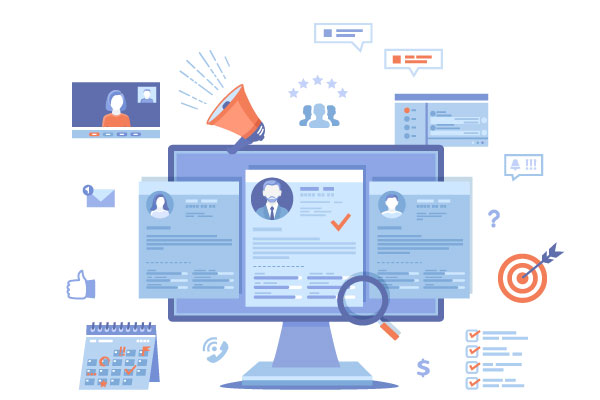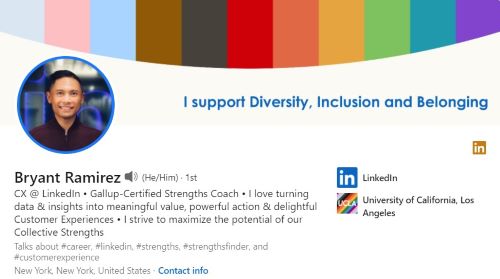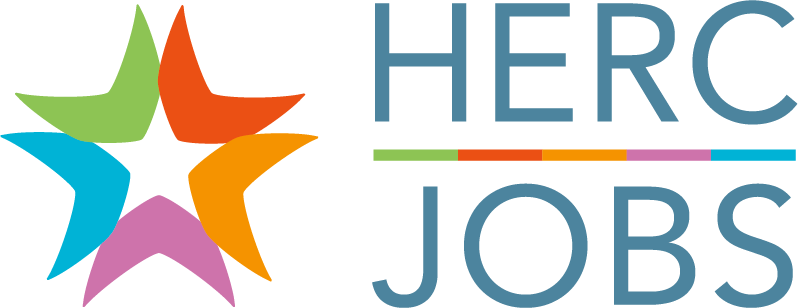Use Your LinkedIn Profile to Tell Your Story

When creating a LinkedIn profile, some people simply copy and paste sections from their resume. Using your resume is a good starting point for your LinkedIn profile, but doing only that doesn’t make use of all the bells and whistles offered by that social media platform.
A resume on its own can be quite flat, with facts and stats about your professional background and experience. With a LinkedIn profile, you have the ability to showcase your work, creativity, and, perhaps most importantly, professional story.

Focus on these sections of your LinkedIn profile to get noticed by potential employers and your peers.
Profile Photo
A profile photo is a basic element of a LinkedIn profile, but it’s surprising how many people skip uploading one. When people view your profile, being able to see your face shows that you’re a real person, not a fake account. It can also help your connections recognize you, whether you’re trying to add them to your network or if they’re looking for you.
Headline
The second text element of your profile that people will see (the first being your name) is your headline. The default headline on LinkedIn is your most recent job title and company. Since that information appears later in your profile, you should change your headline to communicate something else about you. Your headline could reference aspects of your work that you are most passionate about or your strongest skills or your values/mission statement. Keep it fresh – don’t be afraid to revisit and change your headline every now and then.
Cover Photo
The cover photo is another highly visible part of your LinkedIn profile that many people don’t bother to add. While your profile photo shows who you are, your cover photo is another visual way to demonstrate who you are, what you do, and/or what you’re passionate about. For instance, you could upload a photo of you in action at work, such as giving a lecture, or it could showcase something you produced, like a photo at an event you organized. Instead of a photo, it could be the cover artwork of a report or presentation that you put together.
Experience
Descriptions
In the description sections under “Experience,” it’s easy to stick to the bullet points included in your resume. During the LinkedIn Rock Your Profile webinar hosted by HERC, many participants asked if it was better to use bullet points or prose. Our speaker, Bryant Ramirez, recommended using both, but he emphasized that you can use this space to highlight your story and professional journey.
You can’t tell from those standard resume bulletpoints why someone chose to take that position at that company or what having that position meant to that person. Perhaps it was this person’s dream job since childhood or maybe they had a special connection to the community served by that organization. Share that story as prose, then use bulletpoints to convey your job responsibilities and accomplishments.
Media
Included in the “Experience” part of your LinkedIn profile are places to upload “Media” – work samples or other pieces that illustrate your skills and expertise. Potential employers may not see samples of your work until after your resume reached their radar and you’ve been invited to be interviewed. LinkedIn makes it easy for you to call attention to projects you’ve completed right away. Add media to your profile, whether it’s a report or case study that you wrote or a link to a video or article that you produced or participated in.
Recommendations
References are often requested near the end of the interviewing process and, usually, only final candidates are asked to provide them. If you have some impressive references or you have too many to include on your reference list, ask those connections to post a recommendation on your LinkedIn profile. Their stories about you and your work could make a difference and give a strong first impression to potential employers.
Social media platforms like LinkedIn have changed the way job seekers and employers find and interact with each other. Use their features and tools creatively to stand out and differentiate yourself from other job seekers!
About the Author: Marcia Silva is the director of marketing and communications at the Higher Education Recruitment Consortium. She strives to create engaging, research-informed content that empowers job seekers and employers committed to creating inclusive workplaces. She is passionate about supporting nonprofit organizations in using digital media and technology to encourage participation, build trust, and strengthen communities.
